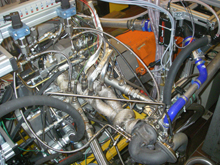| Storing energy with compressed
air, rather than batteries, could cut the cost of hybrids.
A new kind of hybrid vehicle being developed
at the Swiss Federal Institute of Technology in Zurich could save almost
as much fuel as today's gas-electric hybrids, but at a fraction of the
cost. Swiss researchers will present the results of experiments with a
test version of the new system at the Society for Automotive Engineer's
Congress in April.
|
Conventional vehicles use engines that can
provide far more power than is needed for cruising--this excess power is
used during acceleration and for sustaining very high speeds. But these
engines are inefficient, especially since most of the time they operate
at far lower loads than they were designed for.
Guzzella's design replaces a two-liter gasoline engine with a very small 750-milliliter one that's adequate for cruising speeds. It uses compressed air to provide boosts of power for acceleration. The dense, compressed air provides the oxygen needed to burn larger amounts of fuel than usual, a technique called supercharging. A similar approach is already used in some production vehicles, where exhaust gases drive a turbocharger. But turbochargers are known for a problem called "turbo lag"--a noticeable delay between when the accelerator is depressed and when the extra power kicks in. The lag is the result of the time it takes for the turbine in a turbocharger to start spinning fast enough. Guzzella says his system suffers no such delay, providing extra power instantly. That's could make the technology more appealing to consumers, says Zoran Filipi, a professor of mechanical engineering at the University of Michigan, who was not involved with the research. About 80% of the efficiency gain in Guzzella's system comes from using the small engine. Some of the rest comes from capturing energy from braking and then using it for acceleration--over short distances the car can be propelled by compressed air alone, using no fuel. Fuel is also saved by adjusting the load on the engine to keep it running at optimal efficiency, either by increasing the load by using some of the pistons to compress air, or by decreasing the load by using some compressed air to drive the pistons. Finally, compressed air can be used to restart the engine, making it practical for the system to turn the engine off whenever the car comes to a stop, rather than idling. Guzzella's efficiency and performance claims are based on computer models. But he has also demonstrated the basic components of his design in a test engine. The test set-up uses compressed air to drive the pistons, provide supercharging and start the engine. The next steps are to optimize the engine in an attempt to achieve the efficiency levels predicted by the computer models. Guzzela's hybrid concept will face stiff competition from other technologies designed to improve fuel efficiency however. Turbochargers are getting better, and other new technologies have shown promise for addressing the turbo-lag problem, says Michael Duoba, a researcher at the Energy Systems Division of Argonne National Laboratory in Chicago, IL. He also says that what's most important is not the performance on any one technology, but how well that technology can combine with others now being employed to improve efficiency, such as direct injection and improved transmissions. But Duoba notes that Guzzella's system has a distinct advantage. It requires very little extra equipment--just the controls for an extra valve for managing the compressed air and an air tank. The existing engine does the rest. Any time you can make the same equipment do more, he says, "that's a good thing." |
